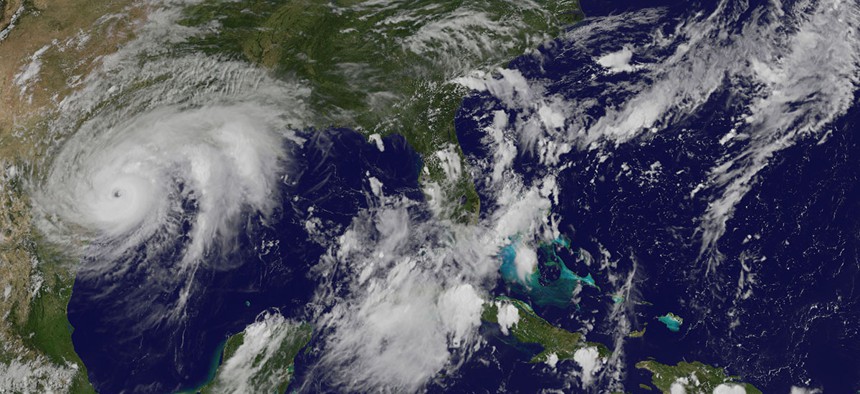How NOAA Plans to Improve Tracking Harvey-Like Storms

This enhanced satellite image made available by the NOAA GOES Project shows Hurricane Harvey, middle left, approaching the coast of Texas on Friday, Aug. 25, 2017. NOAA/AP
As the agency's next-gen satellites come online, it expects more accurate forecasts and increased lead time for severe weather.
Hurricane Harvey has already claimed the lives of more than two dozen people, displaced tens of thousands across Texas and could eventually cost as much as $75 billion in damages.
But those figures may be lower than what they otherwise might have been given the accuracy of early prediction models from the National Hurricane Center. The NHC, part of the National Oceanic and Atmospheric Administration, used computer models parsing data from weather satellites and other instruments to correctly predict Harvey’s Friday landfall in Southeast Texas three days before the storm did just that.
The NHC’s model called for potential flooding and storm surges 72 hours before the storm crashed into the Texas coastline.
» Get the best federal technology news and ideas delivered right to your inbox. Sign up here.
In the near future, NOAA’s computer models, which are based on data points like wind speed, cloud movement and moisture levels, are expected to improve further when NOAA’s next-generation geostationary satellite system comes online, according to Steve Goodman, the chief scientist for NOAA’s GOES-R fleet.
GOES-16, which stands for Geostationary Operational Environmental Satellite, is the first of three satellites in the new $11 billion constellation. Launched in November, GOES-16 is expected to be fully operational in the coming months.
The GOES-R fleet brings an exponential upgrade to the amount of data NOAA’s computer models use, producing up to nine terabytes of weather information per day—a total that will double in 2018 when the second GOES-R satellite is launched. That’s the equivalent of 30,000 CD-ROMs full of weather data.
“We’re an enabling capacity for the forecasters, and the ultimate hope is we’ll have more accurate forecasts and warnings and get an increase of lead time that we all expect will help save lives and property,” Goodman told Nextgov.
The volume of raw weather data is important, Goodman said, and required extensive modernization of the ground systems and algorithms NOAA uses to receive and analyze it. But GOES-R will also improve the kinds of data forecasters can access and the speed at which they can make important decisions, such as issuing warnings.
“It’s been 22 years since we last had new imaging technology,” Goodman said. NOAA began budgeting and developing the current aging GOES fleet of satellites in 1999 using imaging technology that was already a little old. GOES-R is a “monumental upgrade” over existing weather satellites, Goodman said, and part of the reason it takes scientists nearly a year to validate the satellite is because of its sophisticated instruments and capabilities.
For example, GOES-R will have four times better spatial resolution than today’s crop of aging GOES satellites. From its position 20,000-plus miles above sea level, GOES-R will allow forecasters far better imaging of cloud tops and storm formations that could alert forecasters to a potential weather event before a storm eye forms, Goodman said.
GOES-R will also scan the Earth through 16 spectral bands as opposed to today’s crop, which only scans through five bands. One key GOES-R spectral band will allow forecasters to see where moisture in a storm system is piling up—and conversely, where dry air is located—which can be used to predict whether and how much a storm will intensify.
GOES-R is also equipped with a lightning mapper, a new capability that allows the satellite to “see” every lightning strike in the air or toward the ground.
“With these different bands, we can see different things about what is happening in the atmosphere, put it together and have a visual impact to see what is really going on,” said Michael Stringer, acting systems program director for GOES-R.
The current GOES fleet can observe specific weather systems through a spectral band once every minute, but “at one-quarter the resolution of GOES-R and at the cost of doing everything else,” Stringer said.
When current GOES satellites observe a system through a spectral band, they aren’t able to simultaneously image the remaining continental United States. In other words, it can’t do those two important things at once. GOES-R, however, will.
Moreover, the latency getting data from scans drops from several minutes down to approximately 23 seconds, meaning the images of storms forecasters see are essentially a real-time look at the storm.
“The benefit of GOES-16 and the entire series is that it can do up to 30-second [refreshes] while also doing five-minute images of the whole [continental U.S.] and 15-minute images of the full disk of the hemisphere,” Stringer said. “With the legacy system, if you wanted to go to one-minute imagery, you’d have to give up everything else.”
While GOES-R is not officially cleared as operational, the satellite is producing experimental data forecasters can access and have used for decision-making purposes, including regarding Hurricane Harvey, Goodman said. The satellite is operated by NOAA out of its Satellite Operations Center in Suitland, Maryland, with input from the National Weather Service.



